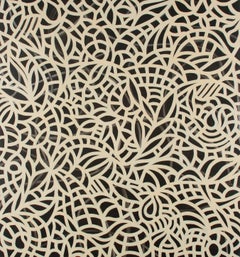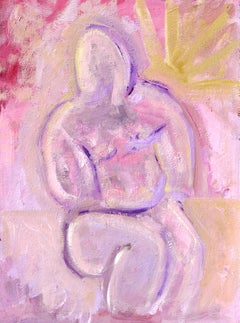John Bonick Art
to
1
Overall Width
to
Overall Height
to
1
1
1
1
1
1
1
8,227
2,805
1,656
1,313
1
Artist: John Bonick
Entanglement #13
By John Bonick
Located in Santa Monica, CA
John Bonick examines natural uncertainty and entanglement. Drawing from his knowledge on quantum reality, Bonick explores the idea that elementary particles do not have pure states, ...
Category
2010s Abstract John Bonick Art
Materials
Oil, Board
Related Items
Vintage Abstract Expressionism -- Pink Figural
By Daniel David Fuentes
Located in Soquel, CA
Abstract figure in pink by by San Francisco, California area artist Daniel David Fuentes (American, 1978-2016), (AKA, Xavier Lundt) (American, 20th Century). From a collection of hi...
Category
1990s Abstract Expressionist John Bonick Art
Materials
Oil, Canvas, Cardboard
$1,276 Sale Price
20% Off
H 20 in W 16 in D 1 in
Golden Gate Bridge
By Mary Hahn
Located in Soquel, CA
Abstracted and modernist painting of the Golden Gate Bridge by Mary Hahn (American, 20th century). Signed lower right. Presented in original bronze ...
Category
1970s Abstract Expressionist John Bonick Art
Materials
Oil, Board
"Waiting" by Dan McCaw, Abstracted, Figural Oil Painting
Located in Denver, CO
Dan McCaw's (US based) "Waiting" is an original, handmade oil painting that depicts an abstracted figure in an interior setting.
Artist Statement:
Born: 1942
A solid foundation o...
Category
2010s Abstract Expressionist John Bonick Art
Materials
Oil, Board
Lady with a Hat Abstract Expressionist Heavy Impasto Figurative Original Oil
Located in Soquel, CA
Lady with a Hat Abstract Expressionist Heavy Impasto Figurative Original Oil
Abstract Expressionist painting of a close-up, expressive portrait of a woman by an unknow artist, rende...
Category
1960s Abstract Expressionist John Bonick Art
Materials
Canvas, Oil, Illustration Board
$1,150
H 18 in W 14 in D 0.13 in
Abstract Impressionist expressive floral oil painting "Roses and two apples"
Located in VÉNISSIEUX, FR
This contemporary expressive impressionist abstract floral painting, Roses and Two Apples, is a radiant work by French artist Natalya Mougenot, known for her emotionally intuitive an...
Category
2010s Abstract Expressionist John Bonick Art
Materials
Oil, Cardboard
$346
H 11.82 in W 9.45 in D 0.12 in
Vintage American Modernist Framed Abstract Expressionist Beach Scene Painting
Located in Buffalo, NY
Vintage abstract beach scene oil painting. Oil on canvas. Framed. Signed. In excellent original condition. Handsomely framed in a wood molding. Excellent condition, ready to han...
Category
1950s Abstract John Bonick Art
Materials
Oil, Board
$1,275
H 25 in W 32 in D 2 in
Painting of the Winter Sunshine with Mountain Lake by 20th Century Dutch Artist
By Joop Smits
Located in Preston, GB
Oil Painting of the Winter Sunshine with Mountain Lake by 20th Century Dutch Artist, Joop Smits (1938-2014)
Art measures 16 x 12 inches
Fr...
Category
Late 20th Century Abstract Impressionist John Bonick Art
Materials
Oil, Board
$2,028 Sale Price
40% Off
H 19 in W 23 in D 3 in
Mid Century Abstract Expressionist Clown Diva
By Jerry W Ward
Located in Soquel, CA
Wonderfully vivid mid century abstract expressionist painting by San Francisco artist Jerry W Ward (American, b. 1968), circa 2000. Titled "Erotic Clown Diva" and signed verso. Condi...
Category
Early 2000s Abstract Expressionist John Bonick Art
Materials
Oil, Cardboard
$1,080 Sale Price
20% Off
H 27 in W 40 in D 0.33 in
Three Masks, Mid Century Abstract
Located in Soquel, CA
Three masks abstract by Novak (American, 20th Century). Presented in a white wooden frame. Signed "Novak" lower right. Image: 28.5"H x 26"W.
Category
1950s Abstract Expressionist John Bonick Art
Materials
Oil, Cardboard
$1,080 Sale Price
20% Off
H 30.75 in W 28.75 in D 1.5 in
"Textures" (2025) by Dan McCaw, Abstracted, Figural Oil Painting
Located in Denver, CO
Dan McCaw's (US based) "Textures" is an original, handmade oil painting that depicts an abstracted figure in a moody interior setting.
Artist Statement:
Born: 1942
A solid founda...
Category
2010s Abstract Expressionist John Bonick Art
Materials
Oil, Board
$9,500
H 30 in W 24 in
Bright Colorful Abstract Expressionist
By Anthony Rappa
Located in Soquel, CA
Bright, colorful abstract expressionist piece by Monterey, California artist Anthony Rappa (American, 20th Century). Heavy, textured pa...
Category
1980s Abstract Expressionist John Bonick Art
Materials
Canvas, Oil, Cardboard
$1,480 Sale Price
20% Off
H 24 in W 30 in D 0.13 in
Large Geometric Abstract Mixed Media Titled Africana
Located in Lake Worth Beach, FL
Africana
Mid-Century Modern large and impressive mixed media, sand and oil on artist board. The painting is unsigned there is a small fragment of old paper label with number #21 titl...
Category
1960s Abstract Geometric John Bonick Art
Materials
Sandstone
John Bonick art for sale on 1stDibs.
Find a wide variety of authentic John Bonick art available for sale on 1stDibs. You can also browse by medium to find art by John Bonick in board, oil paint, paint and more. Much of the original work by this artist or collective was created during the 21st century and contemporary and is mostly associated with the abstract style. Not every interior allows for large John Bonick art, so small editions measuring 56 inches across are available. Customers who are interested in this artist might also find the work of Monroe Hodder, Hyunmee Lee, and Michel Tabori. John Bonick art prices can differ depending upon medium, time period and other attributes. On 1stDibs, the price for these items starts at $15,000 and tops out at $15,000, while the average work can sell for $15,000.


